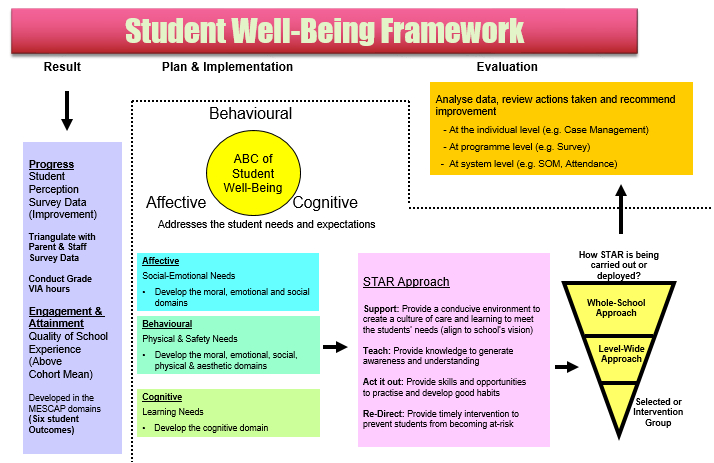Student Well Being Framework
Curricular Goal

Student Development in Punggol View Primary School is a school-based construct that aims to address the Affective, Behavioural and Cognitive (ABC) needs of our students as well as to provide our students with learning opportunities to engage their social and emotional, and self-leadership development.
Student Life can be categorised into the following 3 dimensions, namely
- affective,
- behavioural and
- cognitive
(also known as the ABC of Student Well-Being).
This construct is by no means hierarchical or will operate in isolation. A student may have more than one dimension of needs and the school would need to address these needs as a whole. For instance, a student coming from a disadvantaged family may require physical needs (such as financial assistance and free breakfast), affective needs (such as counselling and positive peer support) and cognitive needs (such as learning support from a teacher) in order to experience success in school.
The school referred to Maslow’s Hierarchy of Needs to draw up the ABC of Student Life. Such categorisation of student well-being provides a guide for school and staff to plan and implement appropriate preventative and intervention approaches and programmes to meet the diverse student needs and expectations.
Planning and Implementation
The STAR approach comprises 4 key strategies which are adopted as a school-wide approach to help the school leaders and staff to adopt specific strategies to enhance student morale and well-being.
The STAR approach comprises the following:
- Support : to provide a conducive environment to create a culture of care and learning to meet our students’ needs and expectations
- Teach : to provide knowledge to generate awareness and understanding
- Act : to provide skills and opportunities to practise and develop good habits and appropriate social behaviours
- Re-Direct: To provide timely interventions to guide students to modify and adopt appropriate behaviours and actions
The STAR approach is applicable for all responses to prevent and intervene students from being deemed to be at-risk when their needs are not addressed or are lacking in school’s expectations as well as to develop student leaders.
a) Affective Dimension
This refers to the provision of the socio-emotional needs of the students through teacher-student interaction, form-teacher guidance programme and support services from the Case Management Team and Discipline Committee.
b) Behavioural Dimension
This refers to the needs and expectations for physical health and nutrition (e.g. health education), preventive health care (e.g. smoking and drugs), economic support (e.g. financial assistance), and safety and security (e.g. discipline management). These are identified to ensure that the school has put in place its holistic health, discipline and school safety frameworks, monitors the physical and safety well-being of the students and ensures that the students will remain healthy, happy and safe.
The school has adopted a values-based discipline to re-direct students with behavioural issues. The school believes that creating a safe and caring environment would be crucial for the students to learn good values and become a person of good character. School rules and the consequences of violating the rules are spelt out clearly in the Student Handbook. The school rules aim to reinforce the practice of the R³ICH values and develop the SE Competencies.
The school recognises the importance of collaboration and relationship management when our students grow and venture out into the VUCA (volatile, uncertain, complex, ambiguous) future. Our students will need to be equipped with the essential knowledge and skills and possess affectionate disposition to make responsible decisions when they are faced with relational difficulties in future.
Hence, our school adopts a two-pronged approach to discipline, applying the concepts of Restorative Practices (RP) and Responsible Thinking Process (RTP). The concepts of RP and RTP are implemented hand-in-hand and complement each other.
With the notion of student-centric, value-driven education in mind, RP allows the children involved to:
- have a chance to share their side of the story and be understood
- understand better how the misbehaviour or conflict happened
- realise how their actions affect others
- take responsibility to manage their own feelings and that of others
- contribute to ways to put things right or to make things better in future
Through the RP process, what is being restored is often something between the people involved such as relationships and friendships, effective communication, respect and empathy. Within the individual itself, a sense of security, self-confidence, self-respect and dignity is often restored as well. As a whole, the RP process results in the restoration of the students’ sense of belonging to the school community.
While RP’s focus is on repairing harm and restoring relationships, RTP focuses on the process of monitoring their own behaviour by taking responsibility for what they do. This may include harm done to oneself and irresponsible behaviour affecting one’s own well-being for example, in issues such as late-coming and delay in the completion and submission of assignments. RTP is designed to develop a sense of responsibility for their own lives and respect for everyone around them, based on Perceptual Control Theory (Powers, 1973).
Through RTP, respect is being taught to the students by the following ways:
- listen to what the student is saying without being critical and without trying to control their answers
- by focusing the student on how they are disturbing others, showing respect for others and respect for rules are being taught
- by asking the students questions that will help them acknowledge and resolve the problem, respect and the notion of accepting consequences for their actions are being taught
All in all, it is in the spirit of nurturing the Singapore heartbeat in our students with the aim that they will make sound decisions based on moral thinking, moral feeling and moral actions.
c) Cognitive Dimension
This refers to the need for learning so as to promote student motivation and engagement in learning. The school has put in place a systematic identification, monitoring, assessment and provision of support for students requiring learning intervention and special needs support.

